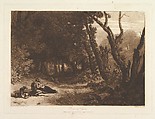Procris and Cephalus, part ViII, plate 41 from "Liber Studiorum"
Designed and etched by Joseph Mallord William Turner British
Engraver George Clint British
Publisher Joseph Mallord William Turner British
Not on view
Turner distilled his ideas about landscape In "Liber Studiorum" (Latin for Book of Studies), a series of seventy prints plus a frontispiece published between 1807 and 1819. To establish the compositions, he made brown watercolor drawings, then etched outlines onto copper plates. Professional engravers usually developed the tone under Turner's direction, and Clint here added mezzotint to describe a tragic couple in a wooded landscape. Ovid's "Metamorphoses" recounts how the hunter Cephalus accidentally shot his wife, the Athenian princess Cephalus, and the critic John Ruskin wrote, "I know of no landscape more purely or magnificently imaginative, or bearing more distinct evidence of the relative and simultaneous conception of the parts." The letter "H" in the upper margin places the work within Turner's category of Historical landscape.
Due to rights restrictions, this image cannot be enlarged, viewed at full screen, or downloaded.


